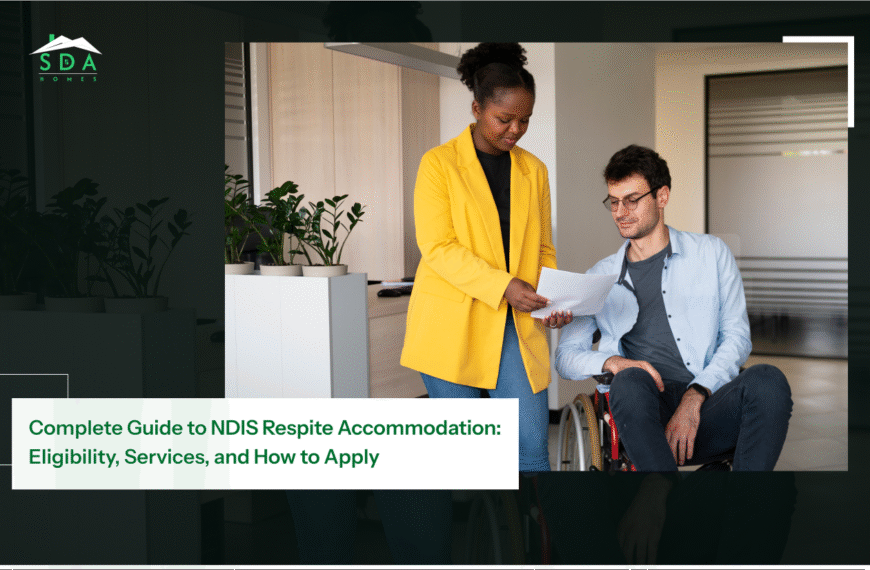Introduction
The National Disability Insurance Scheme continues to evolve, and with it, the Specialist Disability Accommodation (SDA) is also getting an upgrade for 2025-26. These changes go beyond pricing and design standards. The primary goal of the NDIS SDA rules change is to improve housing quality, accessibility, and participant choice while ensuring providers meet higher compliance and design expectations.
Well, this is documented stuff. In this blog post, we talk about what these new SDA rules really mean for people with disabilities, especially NDIS participants and organizations on the ground.
Let’s unveil what has changed, why it matters, and how you can prepare for the 2025-26 phase.
What’s New in the 2025-26 NDIS Rules
The NDIS has introduced updated SDA pricing, clearer design standards, and enhanced compliance measures to meet the growing demand for safe, inclusive housing options among Australians with disabilities.
Here’s highlighting what’s changed for the 2025-26 SDA rules:
1. Updated Pricing and Payment
- The NDIS has included revised rates across all SDA categories, from improved liveability to high physical support, in the “SDA Pricing Arrangements and Pricing Limit 2025-26.”
- They have adjusted the prices to meet construction cost changes, regional demand, and inflation.
- The funding for shared accommodation is now refined to better reflect actual participant needs.
2. Design Standard Review and Compliance Alignment
- The underway NDIS SDA Design Standard Review introduces tighter quality controls on accessibility, safety, and energy efficiency.
- The new guidelines aim to ensure every SDA dwelling meets universal design principles, which could benefit not only participants but also providers in the long-term property value.
3. Stricter Provider Compliance and Reporting
- ALL SDA dwellings will undergo stricter inspections to ensure genuine accessibility and participant safety.
- Providers must now demonstrate ongoing compliance through updated enrollment and auditing requirements.
- The main focus is on maintaining transparency, requiring them to clearly disclose obligations and to encourage participant-centric communication.
What do these new rules of SDA by NDIS mean for participants?
Every change aims to be better than the existing and previous ones and contains such key factors that make them unique and reliable. For NDIS participants, the updated SDA rules bring more choice, safety, and control.
Greater Housing Choice
Compared to the previous setup, NDIS participants now have access to a wider range of SDA properties designed with comfort and inclusivity in mind. There is more clarity on categories, which allows participants to pick housing that meets their functional needs and lifestyle.
Simplified Routes
The updated regulations aim to streamline the SDA funding process. Eligible participants can now apply easily and get approved faster.
Better Transparency
Providers have clear instructions to be more open about pricing, location, and compliance status. This helps participants and their families make informed housing decisions, which reduces confusion during the NDIS planning process.
Empower Decision Making
Participants under the new rules can take an active role in choosing their accommodation, as it promotes independence and a sense of ownership over their living arrangements.
Tip: If you are a participant or support coordinator, review your current SDA plan and ensure your housing preferences match the new SDA categories under the 2025 rules.
What Does the New NDIS SDA Rule Mean for Providers?
Similar to participants, the updated SDA rules for 2025-26 mark a period of both opportunity and accountability.
1. Focus on Design Innovation
The new housing design standard review encourages innovation, such as:
- Smart home technologies
- Energy-efficient bulbs
- Flexible layouts are adaptable to different disability needs.
Any providers who integrate these modern design principles early will be in a better position for long-term occupancy and government approval.
2. Strengthen Compliance Obligation
All SDA providers must comply with the revised NDIS Quality and Safety Commission requirements, including more pre-audits, detailed reporting on the condition of assets, and participant feedback mechanisms.
3. Competitive Market Advantage
SDA demand is rising, particularly in the Western Australia region. Hence, providers who demonstrate compliance and participant satisfaction will attract more referrals. Quality reporting, transparency, and positive participant testimonials will make a huge difference.
Challenges and Opportunities With the Changing SDA Rules
Common Challenges
- Increased Cost: Construction, including materials, labor charges, equipment, and audit expenses, is rising.
- Regulatory Compliance: Providers may find the SDA rules overlap with local planning or building codes.
- Vacancy Risks: Funding uncertainty may increase due to the oversupply in some regions, especially metro areas.
Emerging Opportunities
- Partnership Models: Providers, builders, and investors’ collaboration is now more viable due to clearer NDIS funding mechanisms.
- Sustainable Design: Homes that meet new environmental standards may qualify for extra support or attract premium demand.
- Regional Expansion: Demand is growing in regional areas with limited SDA housing, which is demonstrating a gap for new development.
How to Prepare for NDIS SDA Rules 2025-26 Phase
For Providers
- Review the latest draft of the SDA design standard updates
- Audit existing properties to ensure ongoing compliance.
- Update registration and reporting processes before the next audit cycle.
- Engage participants early for feedback on housing performance.
- Link with SDA specialists (architects, compliance consultants) to future-proof new developments.
For Participants
- Contact your support coordinator to review your NDIS plan thoroughly.
- Check whether there’s any change in eligibility under the 2025-26 framework.
- Research SDA providers with current enrolments under the new rules.
- Ask the provider about the compliance certificates and available design categories before choosing accommodation.
- Subscribe to updates from the NDIS and your provider to stay informed.
Choosing the Right SDA Provider in WA
Although NDIS has a firm grip all over Australia, the Western Australia region has the highest number of SDA providers in different locations. Recently, there has been an increasing demand for high-quality SDA housing, especially in Perth suburbs. Providers like SDA Homes WA are energized as the first choice for participants due to their offerings, which include:
- Building an energy-efficient, accessible home that exceeds the current design standard.
- Incorporating participant feedback loops into each project.
- Partnering with local investors and councils to expand SDA availability in underserved regions.
This regional focus aligns perfectly with the intent of the 2025-26 rules, which foster local, participant-driven housing solutions that deliver both quality and community.
The Future Ahead for NDIS SDA
The 2025-26 NDIS SDA rules come with one clear message: Australia’s disability housing system is shifting towards higher standards, greater transparency, and more participant empowerment.
For participants, it means a more meaningful choice and a better quality of life. Meanwhile, providers will have the opportunity to lead the way through compliance excellence and innovation.
Final Remarks
Don’t consider these new changes in the rules of SDA as another regulatory update. This brings an opportunity to reshape disability housing for the better. All you need to do, as a service provider, is to clearly overview and understand the changes in the 2025-26 framework to perfectly align your strategies early and prioritize compliance and participant outcomes. This approach will help you thrive in the evolving NDIS landscape.
If you need to understand how the new SDA rules impact your housing or project, contact SDA Homes WA for expert advice, compliance guidance, and purpose-built accommodation solutions across WA.
FAQs
1. What’s the biggest benefit for participants?
As an NDIS participant, you will get more housing options, simpler funding steps, and better transparency from providers. You can choose a home that truly meets your needs.
2. Will the new SDA rules impact pricing and funding?
Yes, the SDA price limits have been adjusted to reflect construction costs, inflation, and regional demand, which means the funding amount may differ across property categories.
3. How can providers prepare for 2025-26 compliance?
Providers need to audit their properties, review the SDA design standard updates, and refresh registration details. Early action keeps you compliant and avoids costly last-minute changes.
4. Do existing SDA homes need upgrades under the new rules?
Yes, if a home doesn’t meet the new SDA design or accessibility standards, providers must update it or risk losing registration and funding eligibility.











